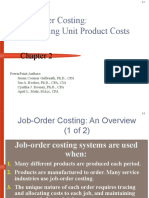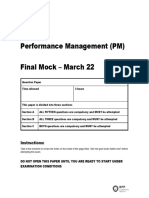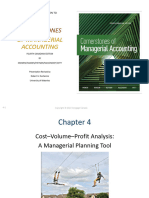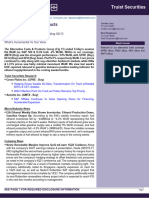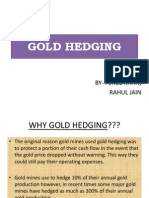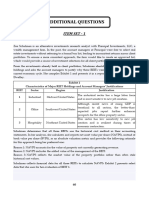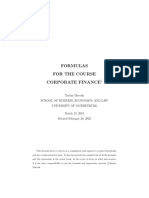MGMT Acct Chapter 5
MGMT Acct Chapter 5
Uploaded by
aman28Copyright:
Available Formats
MGMT Acct Chapter 5
MGMT Acct Chapter 5
Uploaded by
aman28Original Title
Copyright
Available Formats
Share this document
Did you find this document useful?
Is this content inappropriate?
Copyright:
Available Formats
MGMT Acct Chapter 5
MGMT Acct Chapter 5
Uploaded by
aman28Copyright:
Available Formats
Managerial Accounting
Fourth Canadian Edition
Chapter 5
Job Costing
Copyright © 2021 Pearson Canada Inc.
Objective 1
Distinguish between job costing and process costing
Copyright © 2021 Pearson Canada Inc.
Methods Used to Determine the Cost of
Manufacturing a Product
• Most manufacturers use one of two product costing
systems to find the cost of producing their products:
– Process costing
– Job costing
• The end goal : to find the cost of manufacturing one unit of
product.
Copyright © 2021 Pearson Canada Inc.
Process Costing
• Large numbers of identical units
• Continuous and uniform production
• Total costs are averaged over all units
• Examples
– Paint manufacturers
– Oil refineries
– Cereal manufacturers
Copyright © 2021 Pearson Canada Inc.
Job Costing
• Unique, custom products or small batches
• Total costs are accumulated by job
• Examples
– Car repair shop
– Custom home builders
– Advertising agencies
Copyright © 2021 Pearson Canada Inc.
Differences Between Job Costing and
Process Costing
Job Costing Process Costing
Cost object: Job Process
Single units or small
batches with large
Outputs: difference between jobs Large quantities of identical units
Less averaging—costs are More averaging—costs are
averaged over the small averaged over the many identical
number of units in a job units that pass through the
Extent of averaging: (often 1 unit in a job) process
Copyright © 2021 Pearson Canada Inc.
Identify Process or Job Costing
a. A manufacturer of fiberglass insulation
Process costing
b. A residential plumbing contractor
Job costing
c. A manufacturer of fiber optic cable
Process costing
d. A home based jewelry maker
Job costing
e. A hospital
Job costing
Copyright © 2021 Pearson Canada Inc.
Objective 2
Understand the flow of production and how direct
materials and direct labour are traced to jobs
Copyright © 2021 Pearson Canada Inc.
Flow of Inventory Through a
Manufacturing System
Exhibit 5-2
Copyright © 2021 Pearson Canada Inc.
Production Schedule for the Month of
December
Production
Schedule
(partial)
For the Month
of December
Job Description Customer # Employee Scheduled Scheduled
# Start Date End Date
603 Gold crown 17 Dr. Waja 3 12/22 12/23
604 Sports mouthguard × 2 8 Dr. Joseph 1 12/22 12/24
605 Full upper denture 34 Dr. Clissold 5 12/23 12/24
606 Retainer 19 Dr. Mah 3 12/23 12/24
FACTORY CLOSED 12/25 12/31
FOR HOLIDAYS and
ANNUAL
MAINTENANCE
Copyright © 2021 Pearson Canada Inc.
Bill of Materials
Job: 603___ Bill of Materials
Model: Gold crown, 3-6 Quantity: Single___
Date Item
Requisitioned Item Quantity Used
12/23 HL 5 2.3 g
Copyright © 2021 Pearson Canada Inc.
Raw Materials Record Updated for
Materials Received and Used
Raw
Materials
Record
Item Description Minimum
No.: HL : dental Balance : 25
5____ gold____ g____
Received Used Balance
Job
Date g Cost Total Number g Cost Total g Cost Total
11-25 30 $60 $1,800 30 $60 $1,800
11-30 580 1.8 $60 $108 28.2 $60 $1,692
12-02 586 2.7 $60 $162 25.5 $60 $1,530
12-10 591 1.9 $60 $114 23.6 $60 $1,416
Copyright © 2021 Pearson Canada Inc.
Job Cost Record (1 of 2)
Job Cost Record
Job Number: 603_____
Customer: Dr. Waja___________________________________________
Job Description: HL 5 dental gold crown 3-6________________________
Date Started: Dec. 22_____ Date Completed:_____
Manufacturing Cost Information: Cost Summary
Direct Materials
$
Direct Labour
$
Manufacturing Overhead $
Total Job Cost $
Number of Units ÷ 1 unit
Cost per Unit $
Copyright © 2021 Pearson Canada Inc.
Tracing Direct Material Costs to a Job (1 of 3)
• A materials requisition is filled out each time production
needs some raw materials
Materials Requisition
Date: 12/22
Number: #7568
Job: 603
Date Description Quantity Unit Cost Amount
12/22 HL 5 dental gold 2.3 g $60 $138
Total ___$138
Copyright © 2021 Pearson Canada Inc.
Tracing Direct Material Costs to a Job (2 of 3)
• The individual raw materials records are also updated as soon as the
materials are picked
Raw
Materials
Record
Item Description Minimum
No.: HL : dental Balance : 25
5____ gold____ g____
Received Used Balance
Job
Date g Cost Total Number g Cost Total g Cost Total
11-25 30 $60 $1,800 30 $60 $1,800
11-30 580 1.8 $60 $108 28.2 $60 $1,692
12-02 586 2.7 $60 $162 25.5 $60 $1,530
12-10 591 1.9 $60 $114 23.6 $60 $1,416
12-15 30 $60 $1,800 53.6 $60 $3,216
12-22 603 2.3 $60 $138 51.3 $60 $3,078
Copyright © 2021 Pearson Canada Inc.
Tracing Direct Material Costs to a Job (3 of 3)
• The Direct Materials used on the job are updated in the Job Cost
Record Job Cost Record
Job Number: 603_____
Customer: 17 Dr. Waja___________________________________________
Job Description: 1 HL 5 dental gold crown________________________
Date Started: Dec. 22_____ Date Completed:_____
Manufacturing Cost Information: Cost Summary
Direct Materials
Req. #7568: 2.3 g HL 5 $ 138 $ 138
Direct Labour $
Manufacturing Overhead $
Total Job Cost $
Number of Units ÷ 1 unit
Cost per Unit $
Copyright © 2021 Pearson Canada Inc.
DM and DL in Job Cost Record
• The Job Cost Record is updated for Direct Labour Costs
Job Cost Record
Job Number: 603_____
Customer: 17 Dr. Waja___________________________________________
Job Description: 1 HL 5 dental gold crown________________________
Date Started: Dec. 22_____ Date Completed:_____
Manufacturing Cost Information: Cost Summary
Direct Materials
Req. #7568: 2.3 g HL 5 $ 138 $ 138
Direct Labour
No. #324 (9 hours): $160, $20, etc.
No. #327* (1 hour): $ 15
No. #333* (1.5 hours): $ 30
Etc.
(a total of 11.5 direct labour hours) $ 225
Manufacturing Overhead $
Total Job Cost $
Number of Units ÷ 1 unit
Cost per Unit $
Copyright © 2021 Pearson Canada Inc.
Objective 3
Compute a predetermined manufacturing overhead
(MOH) rate and use it to allocate MOH to jobs
Copyright © 2021 Pearson Canada Inc.
Direct Labour and Materials Posted to Job Cost Record
Job Cost Record
Job Number: 603
Customer: For stock
Job Description: 50 units of X4 Elliptical Cross-Trainers
Date Started: Dec. 2_____ Date Completed: _________
Manufacturing Cost Information: Cost Summary
Direct Materials $ 40,000
Req. #7568: $ 8,500
Req. #7580: $ 14,000
Req. # 7595: $ 13,500
Req. # 7601: $ 4,000
Direct Labour $ 10,000
No. #324 (30 hours): $ 600
No. #327 (40 hours): $ 800
No. #333 (36 hours): $ 720
Etc. (a total of 500 direct labour hours)
Manufacturing Overhead $
Total Job Cost $
Number of Units ÷ 50 units
Cost per Unit $
Copyright © 2021 Pearson Canada Inc.
Allocating Manufacturing Overhead to a
Job
• Indirect costs, otherwise known as manufacturing
overhead
• Include depreciation on the factory plant and equipment,
utilities to run the plant, property taxes and insurance on
the plant, etc.
• IFRS and ASPE mandate that manufacturing overhead
must be treated as an inventoriable product cost
• Allocating manufacturing overhead to jobs:
– “Split up” or “divide” the total manufacturing overhead costs
among the jobs we produced during the period
Copyright © 2021 Pearson Canada Inc.
Calculating and Allocating Predetermined
Manufacturing Overhead Rate
Four steps in implementing this basic allocation system:
1. Estimate total manufacturing overhead costs
2. Select an allocation base (cost driver)
3. Calculate predetermined manufacturing overhead rate
(POHR)
Total estimated manufacturing overhead costs
Predetermined MOH rate
Total estimated amount of the allocation base
4. Allocate some MOH to individual jobs
MOH allocated to a job Predetermined MOH rate Actual amount of allocation base used by the job
*POHR stands for “Predetermined Manufacturing Overhead Rate”
Copyright © 2021 Pearson Canada Inc.
Allocating MOH to Individual Job
Example:
Total estimated manufacturing overhead costs = $1,000,000
Cost allocation base is direct labour hours (DLH)
Total estimated DLH for the year = 62,500
Job #603 used 500 DLHs
$1,000,000
Predetermined MOH rate $16 per direct labour hour
62,500 DL hours
MOH to be allocated to Job 603 $16 per direct labour hour 11.5 direct labour hours
$184
Copyright © 2021 Pearson Canada Inc.
Completing the Job Cost Record
Job Cost Record
Job Number: 603_____
Customer: 17 Dr.
Waja________________________________________________________________
Job Description: 1 HL 5 dental gold
crown________________________________________________
Date Started: Dec. 22_____ Date Completed: __Dec. 28___
Manufacturing Cost Information: Cost Summary
Direct Materials
Req. #7568: 2.3 g HL 5 $ 138
$ 138
Direct Labour
No. #324 (9 hours): $160, $20, etc.
No. #327* (1 hour): $ 15
No. #333* (1.5 hours): $ 30
Etc.
(a total of 11.5 direct labour hours) $ 225
Manufacturing Overhead
$16/ DL hour × 11.5 DL hours = $185 $ 185
Total Job Cost $ 547
Number of Units ÷ 1 unit
Cost per Unit Copyright © 2021 Pearson Canada Inc. $ 547
Objective 4
Compute and dispose of overallocated or underallocated
manufacturing overhead
Copyright © 2021 Pearson Canada Inc.
Overhead Application (1 of 2)
• Managers calculate the cost of producing a job by tracing
actual direct materials and direct labour to each job using
materials requisitions and labour time records
• Manufacturing overhead is allocated to each job using a
predetermined overhead rate
• They will have either underallocated manufacturing
overhead (estimated too little) or overallocated
manufacturing overhead (estimated too much)
Copyright © 2021 Pearson Canada Inc.
Overhead Application (2 of 2)
Exhibit 5-15
Copyright © 2021 Pearson Canada Inc.
Overhead Application Example (1 of 3)
Shaw Group has the following actual manufacturing
overhead costs in December:
Manufacturing Overhead Incurred Actual MOH Costs
Indirect materials used (janitorial supplies, machine lubricants, etc.) $ 2,000
Indirect labour (janitors’ and supervisors’ wages, etc.) 13,000
Other indirect manufacturing costs
(Plant utilities, depreciation, property taxes, insurance, etc.) 10,000
Total actual manufacturing overhead costs incurred $25,000
Copyright © 2021 Pearson Canada Inc.
Overhead Application Example (2 of 3)
Manufacturing overhead is allocated to jobs, based on the
predetermined overhead rate of $16 per DLH:
Job Amount of MOH Allocated to Job
603 (from Exhibit 5-14) ($16 per DL hour × 11.5 DL hours) $ 184
604 (not shown) ($16 per DL hour × 1,488.5 DL hours) 23,816
Total MOH allocated to jobs ($16 per hour × 1,500 DL hours) $24,000
Copyright © 2021 Pearson Canada Inc.
Overhead Application Example (3 of 3)
Recall that the predetermined MOH rate was:
$1,000,000
Predetermined MOH rate $16 per direct labour hour
62,500 DL hours
Total manufacturing overhead allocated to jobs is based on
1,500 ACTUAL DLH’s:
Total MOH allocated Predetermined MOH rate Actual total amount of allocation base used on all jobs
$16 per DL hour 1,500 direct labour hours
$24,000 total MOH allocated to jobs during the period
Actual manufacturing overhead costs incurred $25,000
Manufacturing overhead allocated to jobs 24,000
Underallocated manufacturing overhead $ 1,000
Copyright © 2021 Pearson Canada Inc.
Underallocated or Overallocated
Manufacturing Overhead (1 of 4)
• Underallocated (actual is greater than allocated)
– not enough allocated to jobs
– too little charged to product cost
• Overallocated (actual is less than allocated)
– too much allocated to jobs
– too much charged to product cost
Copyright © 2021 Pearson Canada Inc.
Underallocated or Overallocated
Manufacturing Overhead (2 of 4)
• Assuming that:
– The amount of under or overallocation is immaterial; or
– Most of the inventory produced during the period has been
sold
• Manufacturers will make adjustments, as required
Copyright © 2021 Pearson Canada Inc.
Objective 6
Prepare journal entries for a manufacturer’s job costing
system
Copyright © 2021 Pearson Canada Inc.
Quick Check
Copyright © 2021 Pearson Canada Inc.
Quick Check Question (1 of 5)
1. Which of the following companies would be most likely to
use a job costing system rather than a process costing
system?
a. Steel manufacturer
b. Legal firm
c. Beverage bottler
d. Paint manufacturer
Copyright © 2021 Pearson Canada Inc.
Quick Check Answer (1 of 5)
1. Which of the following companies would be most likely to
use a job costing system rather than a process costing
system?
a. Steel manufacturer
b. Legal firm
c. Beverage bottler
d. Paint manufacturer
Copyright © 2021 Pearson Canada Inc.
Quick Check Question (2 of 5)
2. In a job costing system, all of the following statements
about materials are correct EXCEPT for which of the
following?
a. A materials requisition is used to request materials needed
from the storeroom.
b. The job cost record for a job will contain all direct material
used for that particular job.
c. Materials that cannot be traced to a particular job are treated
as manufacturing overhead.
d. All materials are always classified as direct materials.
Copyright © 2021 Pearson Canada Inc.
Quick Check Answer (2 of 5)
2. In a job costing system, all of the following statements
about materials are correct EXCEPT for which of the
following?
a. A materials requisition is used to request materials needed
from the storeroom.
b. The job cost record for a job will contain all direct material
used for that particular job.
c. Materials that cannot be traced to a particular job are treated
as manufacturing overhead.
d. All materials are always classified as direct materials.
Copyright © 2021 Pearson Canada Inc.
Quick Check Question (3 of 5)
3. The formula to calculate the amount of manufacturing
overhead to allocate to jobs is:
a. predetermined overhead rate times the actual amount of the
allocation base used by the specific job.
b. predetermined overhead rate divided by the actual allocation
base used by the specific job.
c. predetermined overhead rate times the actual manufacturing
overhead used on the specific job.
d. predetermined overhead rate times the estimated amount of
the allocation base used by the specific job.
Copyright © 2021 Pearson Canada Inc.
Quick Check Answer (3 of 5)
3. The formula to calculate the amount of manufacturing
overhead to allocate to jobs is:
a. predetermined overhead rate times the actual amount of
the allocation base used by the specific job.
b. predetermined overhead rate divided by the actual allocation
base used by the specific job.
c. predetermined overhead rate times the actual manufacturing
overhead used on the specific job.
d. predetermined overhead rate times the estimated amount of
the allocation base used by the specific job.
Copyright © 2021 Pearson Canada Inc.
Quick Check Question (4 of 5)
4. If a company underestimates the amount of the allocation
base when calculating its predetermined manufacturing
overhead rate, but estimates the amount of manufacturing
overhead costs correctly, the amount of manufacturing
overhead allocated for the year likely will be:
a. underallocated.
b. overallocated.
c. exactly equal to the actual manufacturing overhead for the
year.
d. cannot be determined from the information given.
Copyright © 2021 Pearson Canada Inc.
Quick Check Answer (4 of 5)
4. If a company underestimates the amount of the allocation
base when calculating its predetermined manufacturing
overhead rate, but estimates the amount of manufacturing
overhead costs correctly, the amount of manufacturing
overhead allocated for the year likely will be:
a. underallocated.
b. overallocated.
c. exactly equal to the actual manufacturing overhead for the
year.
d. cannot be determined from the information given.
Copyright © 2021 Pearson Canada Inc.
Quick Check Question (5 of 5)
5. If manufacturing overhead is overallocated for the period
by $200, then:
a. the $200 should be prorated between Work in Process
inventory, Raw Materials inventory, and Cost of Goods Sold.
b. actual manufacturing overhead is greater than allocated
manufacturing overhead.
c. jobs have been overcosted during the period.
d. Cost of Goods Sold should be adjusted by an increase of
$200.
Copyright © 2021 Pearson Canada Inc.
Quick Check Answer (5 of 5)
5. If manufacturing overhead is overallocated for the period
by $200, then:
a. the $200 should be prorated between Work in Process
inventory, Raw Materials inventory, and Cost of Goods Sold.
b. actual manufacturing overhead is greater than allocated
manufacturing overhead.
c. jobs have been overcosted during the period.
d. Cost of Goods Sold should be adjusted by an increase of
$200.
Copyright © 2021 Pearson Canada Inc.
You might also like
- Agri Land - VALUATIONDocument4 pagesAgri Land - VALUATIONJagjit SinghNo ratings yet
- The Cost of Doing Business Study, 2022 EditionFrom EverandThe Cost of Doing Business Study, 2022 EditionNo ratings yet
- Chapter - 02 Job Order CostingDocument69 pagesChapter - 02 Job Order CostingGonzalo Jr. RualesNo ratings yet
- P2 41 2 42 SolutionsDocument3 pagesP2 41 2 42 SolutionsMarjorie PalmaNo ratings yet
- P2 41 2 42 SolutionsDocument3 pagesP2 41 2 42 SolutionsMarjorie PalmaNo ratings yet
- FAR 1 - Journal EntriesDocument3 pagesFAR 1 - Journal EntriesAnime LoverNo ratings yet
- Group 4 Job Order CostingDocument226 pagesGroup 4 Job Order CostingJames David Torres MateoNo ratings yet
- Chapter 10 - Flexible Budgets and Standard CostsDocument59 pagesChapter 10 - Flexible Budgets and Standard CostsroyaltystorezNo ratings yet
- C3 - Job Order CostingDocument23 pagesC3 - Job Order Costinghap9630No ratings yet
- LU5.1 Job CostingDocument27 pagesLU5.1 Job CostingVj TjizooNo ratings yet
- Term 2, Academic Year 2020-2021: Management Accounting Group Business Case AnalysisDocument3 pagesTerm 2, Academic Year 2020-2021: Management Accounting Group Business Case AnalysisNevan NovaNo ratings yet
- C02 Instr PPT Mowen4CeDocument73 pagesC02 Instr PPT Mowen4Cepiker.trance.0uNo ratings yet
- Master Budget and Responsibility Accounting Chapter Cost Accounting Horngreen DatarDocument45 pagesMaster Budget and Responsibility Accounting Chapter Cost Accounting Horngreen Datarshipra_kNo ratings yet
- 7 Job Costing Student 2023Document52 pages7 Job Costing Student 2023owmferrierNo ratings yet
- MEM5241 Week2 FinalDocument69 pagesMEM5241 Week2 Finalyu qiuNo ratings yet
- CPA Canada Core 2 Mock Exam - Bolt Blades LTDDocument6 pagesCPA Canada Core 2 Mock Exam - Bolt Blades LTDAva DasNo ratings yet
- Job Order Costing Calculating Unit Product CostsDocument9 pagesJob Order Costing Calculating Unit Product CostsMomo HiraiNo ratings yet
- Chapter 1. Introduction To Cost TermsDocument17 pagesChapter 1. Introduction To Cost TermsfekadeNo ratings yet
- Session 5 Job CostingDocument58 pagesSession 5 Job CostingJoeyNo ratings yet
- Chapter 5 - Job Order CostingDocument20 pagesChapter 5 - Job Order CostingviraNo ratings yet
- A WK3 Chp2Document83 pagesA WK3 Chp2Jocelyn LimNo ratings yet
- Job Costing and Batch CostingDocument12 pagesJob Costing and Batch Costinglc17358No ratings yet
- CostingDocument15 pagesCostingCherryll MancenidoNo ratings yet
- Job Order CostingDocument6 pagesJob Order CostingGabrielle-Nicole PowellNo ratings yet
- Garrison12ce PPT Ch02Document63 pagesGarrison12ce PPT Ch02snsahaNo ratings yet
- Cost12eppt - 04 Job CostingDocument20 pagesCost12eppt - 04 Job Costingfriska13No ratings yet
- Garrison12ce PPT Ch02Document63 pagesGarrison12ce PPT Ch02Yatharth AggarwalNo ratings yet
- 8265 Fa 20Document65 pages8265 Fa 20t588h6s7d2No ratings yet
- ACCOUNTING P2 MEMO GR10 NOV2020 - EnglishDocument8 pagesACCOUNTING P2 MEMO GR10 NOV2020 - Englishjordan2gardnerNo ratings yet
- Chapter 5 - Job Order CostingDocument39 pagesChapter 5 - Job Order CostingHARYATI SETYORININo ratings yet
- Garrison12ce PPT Ch02Document63 pagesGarrison12ce PPT Ch02bertlyn josephNo ratings yet
- Cost Terms, Concepts and Classifications: Prepared by Shannon Butler, Cpa, Ca Carleton UniversityDocument59 pagesCost Terms, Concepts and Classifications: Prepared by Shannon Butler, Cpa, Ca Carleton Universityਜਸਲੀਨ ਕੌਰ ਬਰਾੜNo ratings yet
- Account G12 May2013Document10 pagesAccount G12 May2013ezinhle2710No ratings yet
- CH2 CMP222-2Document52 pagesCH2 CMP222-2donia.temimiNo ratings yet
- Braun Ma6 PPT 03Document66 pagesBraun Ma6 PPT 03Chaitanya ChoudharyNo ratings yet
- Seventeenth Edition, Global Edition: Job CostingDocument63 pagesSeventeenth Edition, Global Edition: Job Costingbecky940704No ratings yet
- CH 05B (Empty)Document3 pagesCH 05B (Empty)Riley CareNo ratings yet
- Costing - As LevelDocument14 pagesCosting - As LevelMusthari KhanNo ratings yet
- Job-Order Costing: Calculating Unit Product CostsDocument46 pagesJob-Order Costing: Calculating Unit Product CostsGigo Kafare BinoNo ratings yet
- Product Cost Flows and Business OrganizationsDocument48 pagesProduct Cost Flows and Business OrganizationsGaluh Boga KuswaraNo ratings yet
- Estimate Detail Form: Item Material Manhours Labor Equipment Subcontract Total or Description Qty Unit CostDocument1 pageEstimate Detail Form: Item Material Manhours Labor Equipment Subcontract Total or Description Qty Unit CostdelwarNo ratings yet
- Accounting NSC P2 QP Nov 2022 EngDocument15 pagesAccounting NSC P2 QP Nov 2022 EngItumeleng MogoleNo ratings yet
- Chapter 2Document80 pagesChapter 2Zahra RouhaniNo ratings yet
- Chapter 2 SolutionsDocument27 pagesChapter 2 SolutionsKaweesha GayathNo ratings yet
- Activity Based Costing - APO 9Document13 pagesActivity Based Costing - APO 9manan guptaNo ratings yet
- Akuntansi ManajemenDocument8 pagesAkuntansi ManajemenAslinda MutmainahNo ratings yet
- Acc102 W2Document28 pagesAcc102 W2Moheb RefaatNo ratings yet
- CH 21Document70 pagesCH 21Shakib Ahmed Emon 0389No ratings yet
- 5-1 - PPT Job Order CostingDocument74 pages5-1 - PPT Job Order CostingfizzawaqNo ratings yet
- Cost Classifications and Cost Assignment - Lecture SlidesDocument21 pagesCost Classifications and Cost Assignment - Lecture SlidesnonkonzovilakaziNo ratings yet
- ManRep Ch03 Process CostingDocument56 pagesManRep Ch03 Process CostingAlexandra NicoleNo ratings yet
- 4.presentazione 12.10.2022Document27 pages4.presentazione 12.10.2022Josefina Martinez GarciaNo ratings yet
- Lecture 11&12 Standard CostingDocument29 pagesLecture 11&12 Standard Costingstefaniya.chanNo ratings yet
- Accounting & Control: Cost ManagementDocument39 pagesAccounting & Control: Cost ManagementKM RobinNo ratings yet
- P1 - Management Accounting - Performance EvaluationDocument24 pagesP1 - Management Accounting - Performance EvaluationSritijhaaNo ratings yet
- March 2022 Final - MockDocument14 pagesMarch 2022 Final - Mockfaranaz RamsahyeNo ratings yet
- C04 Instr PPT Mowen4CeDocument83 pagesC04 Instr PPT Mowen4Cepiker.trance.0uNo ratings yet
- C11Document66 pagesC11phuonganhdh0312No ratings yet
- R&D Productivity: How to Target It. How to Measure It. Why It Matters.From EverandR&D Productivity: How to Target It. How to Measure It. Why It Matters.No ratings yet
- Cost & Managerial Accounting II EssentialsFrom EverandCost & Managerial Accounting II EssentialsRating: 4 out of 5 stars4/5 (1)
- Infosys Whistle Blower Case 1Document11 pagesInfosys Whistle Blower Case 1sinchusheenu21No ratings yet
- Symalakshmi TOPUP House LoanDocument4 pagesSymalakshmi TOPUP House LoanAnn Olivia VallavanadanNo ratings yet
- Appraisal and Assessment of Real PropertyDocument2 pagesAppraisal and Assessment of Real Propertynoemi melaya100% (1)
- Vp°Ffiv 'Phf Lh° Hpµvπka°' 'F: Your DetailsDocument2 pagesVp°Ffiv 'Phf Lh° Hpµvπka°' 'F: Your DetailsAwes HussinNo ratings yet
- Alternative Fuels & Products 2022-02-14Document11 pagesAlternative Fuels & Products 2022-02-14JoeNoceraNo ratings yet
- Project Proposal DraftDocument18 pagesProject Proposal Draftcha100% (5)
- Epik Program: Residence Certificate (SARS)Document2 pagesEpik Program: Residence Certificate (SARS)Duc VietNo ratings yet
- Sales Brochure Iiw2020Document4 pagesSales Brochure Iiw2020hendry syahrialNo ratings yet
- Double 14 EUR - GBP PDFDocument7 pagesDouble 14 EUR - GBP PDFatolikeithNo ratings yet
- Petitioner vs. vs. Respondents Jose W. Diokno Angel M. VecinoDocument3 pagesPetitioner vs. vs. Respondents Jose W. Diokno Angel M. VecinoCamshtNo ratings yet
- IRCTC Retiring RoomDocument2 pagesIRCTC Retiring Roomprakhar.kumarspamNo ratings yet
- Rek-Koran-Mandiri-BASMAN-Nov-Jan-2024 (1) BackupDocument7 pagesRek-Koran-Mandiri-BASMAN-Nov-Jan-2024 (1) Backupkodokhijau7771No ratings yet
- ITC Analysis Using TATA by Screener ExcelDocument12 pagesITC Analysis Using TATA by Screener Excelnamahashivay2No ratings yet
- InvoiceDocument1 pageInvoiceTowsif SalauddinNo ratings yet
- Factors Affecting The Fluctuations in Exchange Rate of The Indian Rupee Group 9 C2Document11 pagesFactors Affecting The Fluctuations in Exchange Rate of The Indian Rupee Group 9 C2Karishma Satheesh KumarNo ratings yet
- Gold Hedging: By-Feroz Khan, Rahul JainDocument13 pagesGold Hedging: By-Feroz Khan, Rahul JainAmar SharmaNo ratings yet
- Modern Management Techniques FOMDocument8 pagesModern Management Techniques FOMPRABHAT KUMAR MBA W 2021-24No ratings yet
- Boarding Pass To KolkataDocument2 pagesBoarding Pass To KolkataA.N.M. Khaleqdad KhanNo ratings yet
- Additional Practice Q Page 60 To Page 104Document45 pagesAdditional Practice Q Page 60 To Page 104sagarramratanNo ratings yet
- Analysis of Green Entrepreneurship Practices in IndiaDocument5 pagesAnalysis of Green Entrepreneurship Practices in IndiaK SrivarunNo ratings yet
- Bustos V Millians Shoe (Jumamil)Document2 pagesBustos V Millians Shoe (Jumamil)Homer SimpsonNo ratings yet
- Rate Anaylsis LouversDocument1 pageRate Anaylsis LouversSyed Tasveer AbbasNo ratings yet
- Inbound 4919948962765325589Document2 pagesInbound 4919948962765325589jamessantos7197No ratings yet
- Samara UN Model Exam AcfnDocument49 pagesSamara UN Model Exam AcfnTesfu HettoNo ratings yet
- Relay NameDocument27 pagesRelay NamevinaysinghbeenooNo ratings yet
- Ojt Report Capital Budgeting at SJVN PVT Ltd.Document40 pagesOjt Report Capital Budgeting at SJVN PVT Ltd.ashishnaval_29No ratings yet
- Formula Sheet Corporate FinanceDocument19 pagesFormula Sheet Corporate FinancePatricia TekgültekinNo ratings yet
- SUmmative TestDocument9 pagesSUmmative TestDhannamee BentoyNo ratings yet






































